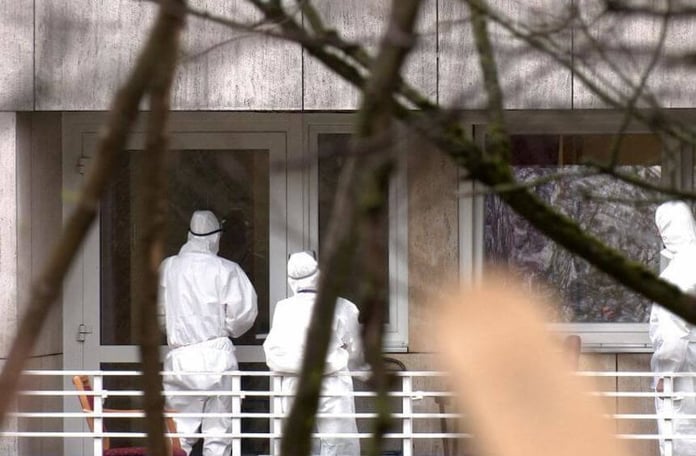
Wolfsburg / Berlin (TEH) – The coronavirus is spreading increasingly in old people’s homes in Germany. After the death of 17 infected people in a nursing home in Wolfsburg, another home in Lower Saxony is struggling with infections.
Three people infected with the coronavirus died again in the St. Nikolaus retirement home in Wurzburg. The district office in Wurzburg announced in the evening that there were two women aged 105 and 94 and an 88 year old man. All three had suffered from severe previous illnesses.
The home only reported the death of an 80-year-old on Sunday evening. A total of 17 people died in the Wurzburg area after a Covid 19 disease, the majority of them in the elderly facility. The remaining residents of the home who tested positive for the virus were isolated on weekends within the facility.
From the perspective of the virologist Christian Drosten, the cases in German nursing homes mark a new phase in the epidemic, which is also associated with more reported deaths. “We are now seeing the entries in retirement homes, for example, and have the beginning of a new development here,” Drosten said on Monday in the NDR podcast.
So far, Germany had also been a bit lucky: First of all, it was younger, sporty people like skiers who infected the virus from vacation and spread it in their networks of about the same age. Most of these people experienced mild illnesses.
Because of several effects at the same time, one will inevitably see an increase in the reported case mortality, said Drosten. You can already see this in the statistics: It is no longer 0.2 to 0.4, but in the range of 0.8 percent. This is due to the fact that different age groups than before are affected by Sars-CoV-2. In addition, diagnostics can no longer keep up with exponential development: “I do not believe that we can realistically significantly increase our current test capacity,” said Drosten with regard to PCR tests.
More than half a million of these could currently be made in Germany every week. However, the Charite virologist says that he is uncertain how long the industry can continue to meet the great need for laboratory reagents.
In view of the coronavirus cases in the homes, patient protectionists are demanding close tests. When a resident is admitted to a home, it must be tested and isolated, the board of the German Patient Protection Foundation, Eugen Brysch, told the (TEH).
Nursing staff or residents must also be tested for influenza infections. Nationwide, around 800,000 people lived in old people’s homes and nursing homes, more than 70 percent of whom had dementia.
If the corona virus is only in a care facility, the respective municipality must monitor it immediately, Brysch demanded. Then you no longer have “100 general practitioners who take care of 100 residents”, but take over the health department. Without protective clothing, a breathing mask, disinfectant and gloves, “you don’t have to start in the nursing home”. So far, at least 50 people have died nationwide in old people’s and nursing homes. The danger of new cases is great.
A criminal complaint against those responsible at Diakonie Wolfsburg for negligent killing does not make sense, said Brysch. “Anyone who is responsible for this crisis is in Berlin.” The public prosecutor’s office in Braunschweig had previously confirmed the receipt of a complaint by a Wolfsburg lawyer on Monday.
The state of Lower Saxony has now ordered an admission freeze for nursing homes. The only exceptions are if a 14-day quarantine for new residents is guaranteed, said Health Minister Carola Reimann. The SPD politician also appealed to relatives to refrain from visiting older relatives. “Please do not visit your loved ones. In this way you protect not only your own mother or father, but everyone. ” There are many indications that the ban on visiting such homes has not been observed.
Most of the 17 people who died in the Wolfsburg home had no symptoms of Covid 19 before death. “On Sunday we had a total of 79 positive people tested in the home,” said Wolfsburg Mayor Klaus Dieter Mohrs (SPD). In the house, where mostly people with dementia live, infected people should be strictly separated from negatively tested residents.
In the Wildeshausen home, the health department tested all 51 residents and 44 employees after an 89-year-old died from serious previous illnesses and a coronavirus infection, the district of Oldenburg said. So far, mild courses have been found in all other patients. The infected residents are said to stay in their rooms for two weeks and are cared for by staff who have also tested positive – strictly separate from residents who have been tested negatively and who are accommodated in single rooms and are cared for by staff who tested negative.
State politicians are now looking at the curve of the total number of infections: According to Interior Senator Andreas Geisel (SPD), it is currently not possible to reliably determine whether the rate of spread of infections with the corona virus in Berlin is already slowing. Lower Saxony’s Minister of Health Carola Reimann sees things similarly. The SPD politician attributed the fact that the number of confirmed new infections in Lower Saxony has decreased slightly in the past few days to the weekend, when fewer tests and reports were made.
The state government of Schleswig-Holstein wants to look at the numbers in the coming weeks. “On this basis, we will have to assess how these measures must be continued beyond April 19,” MP Daniel Gunther told us over the weekend. Bavaria’s Prime Minister Markus Soder (CSU), on the other hand, emphasized that the initial restrictions were beginning to have an effect, “the curve is leveling off”. Currently the number of infected people in Bavaria doubles every 5 days, before the measures the number doubled every 2.8 days.
“In the end, we can probably only make the actual, final assessment of the effectiveness and continuation of the corresponding measures in mid-April,” emphasized Soder. “We have agreed among the federal states that we will do this together.” The common approach is important because the consequences would have a national impact. There is no reason to give the all-clear, so it is not the time for a hasty exit or a corresponding debate. “An exit debate, as understandable as it is, is now out of time.”










